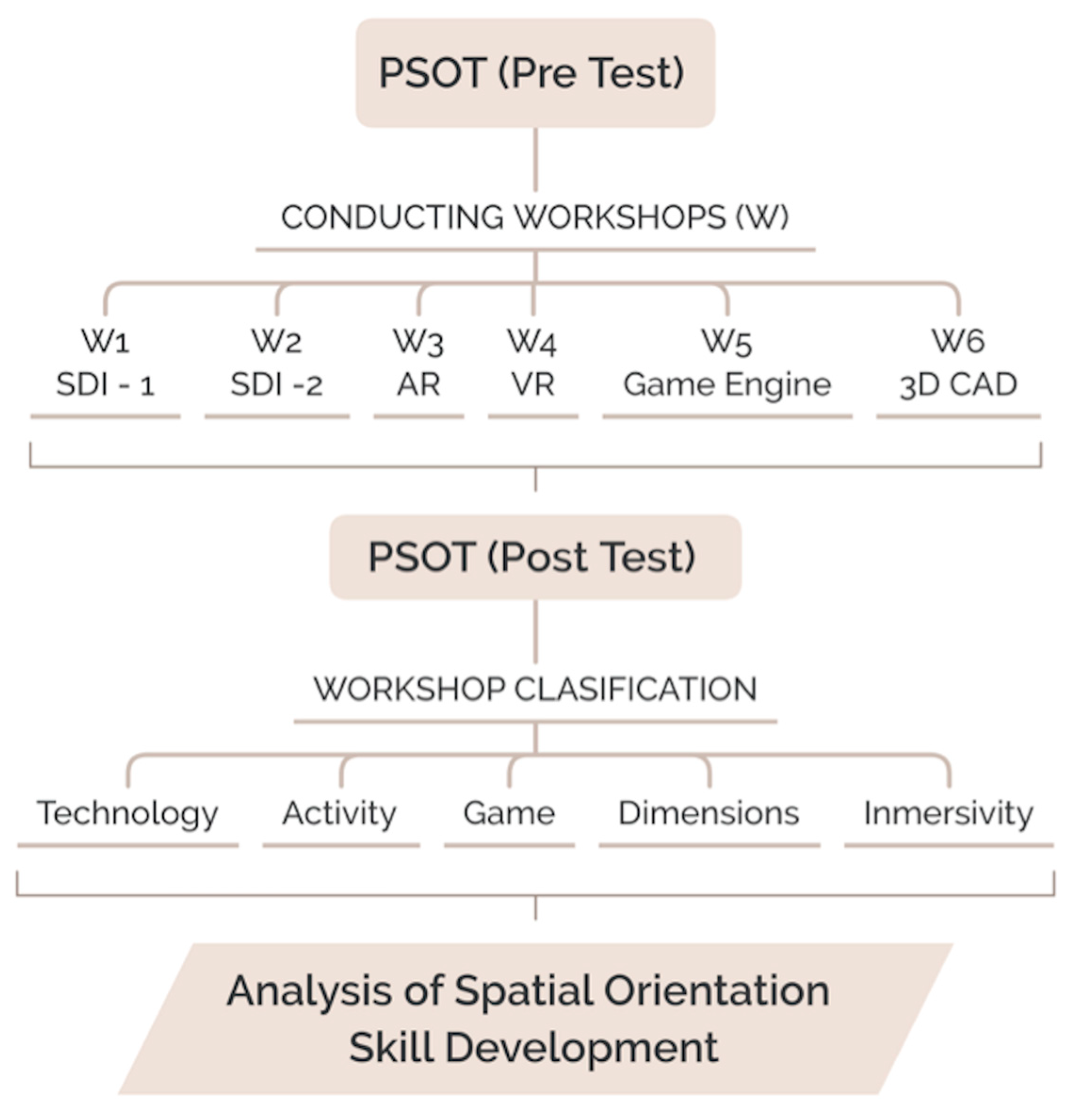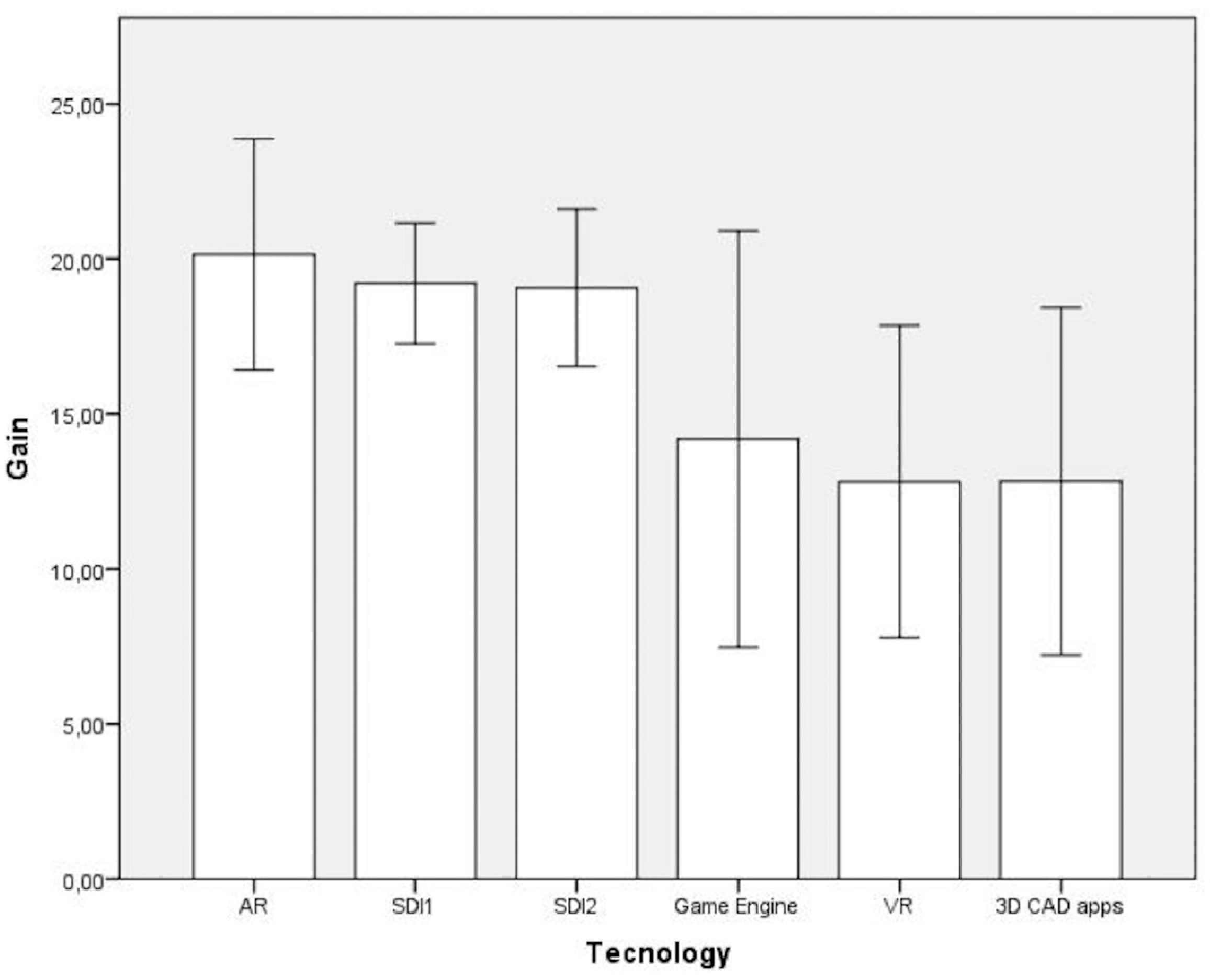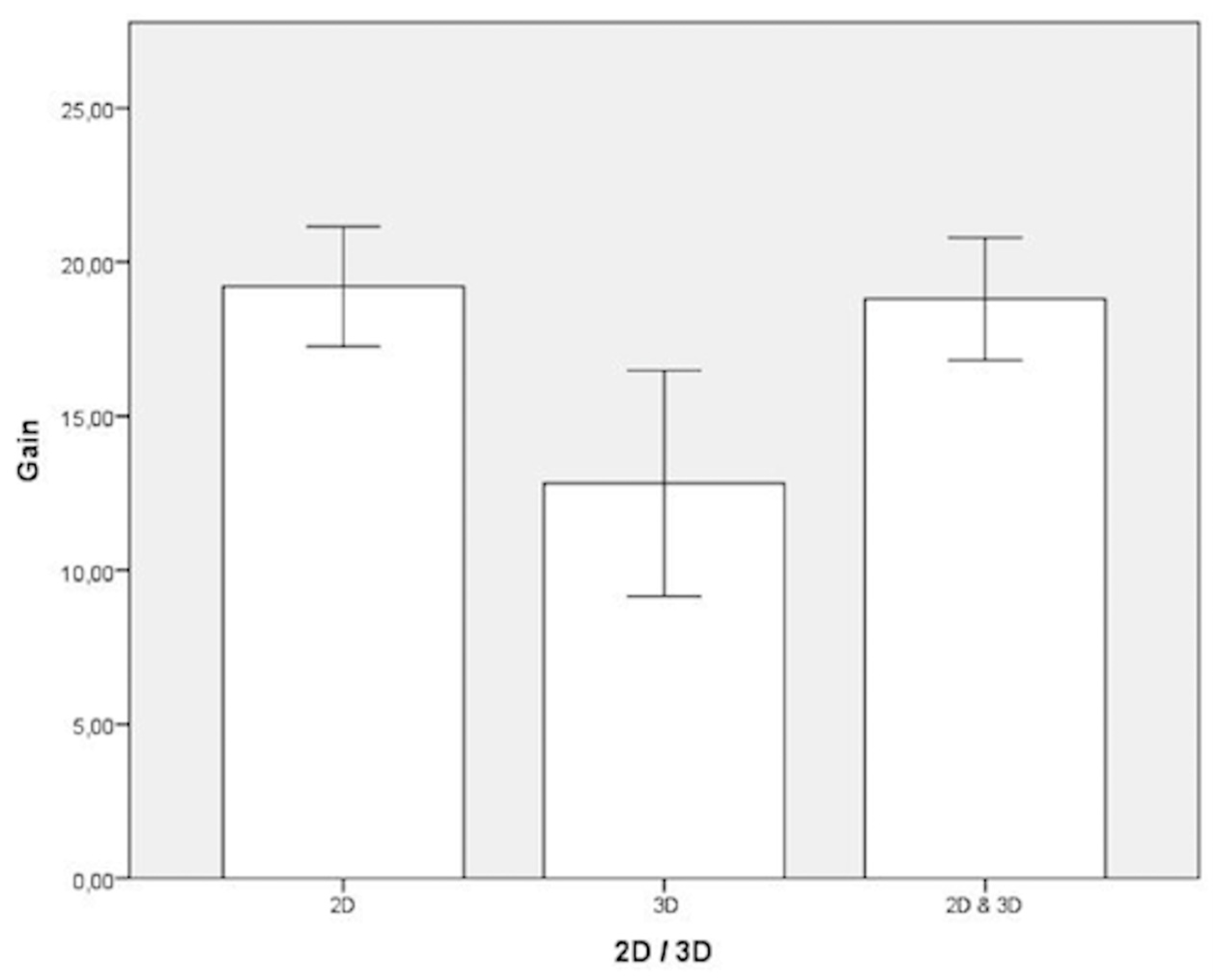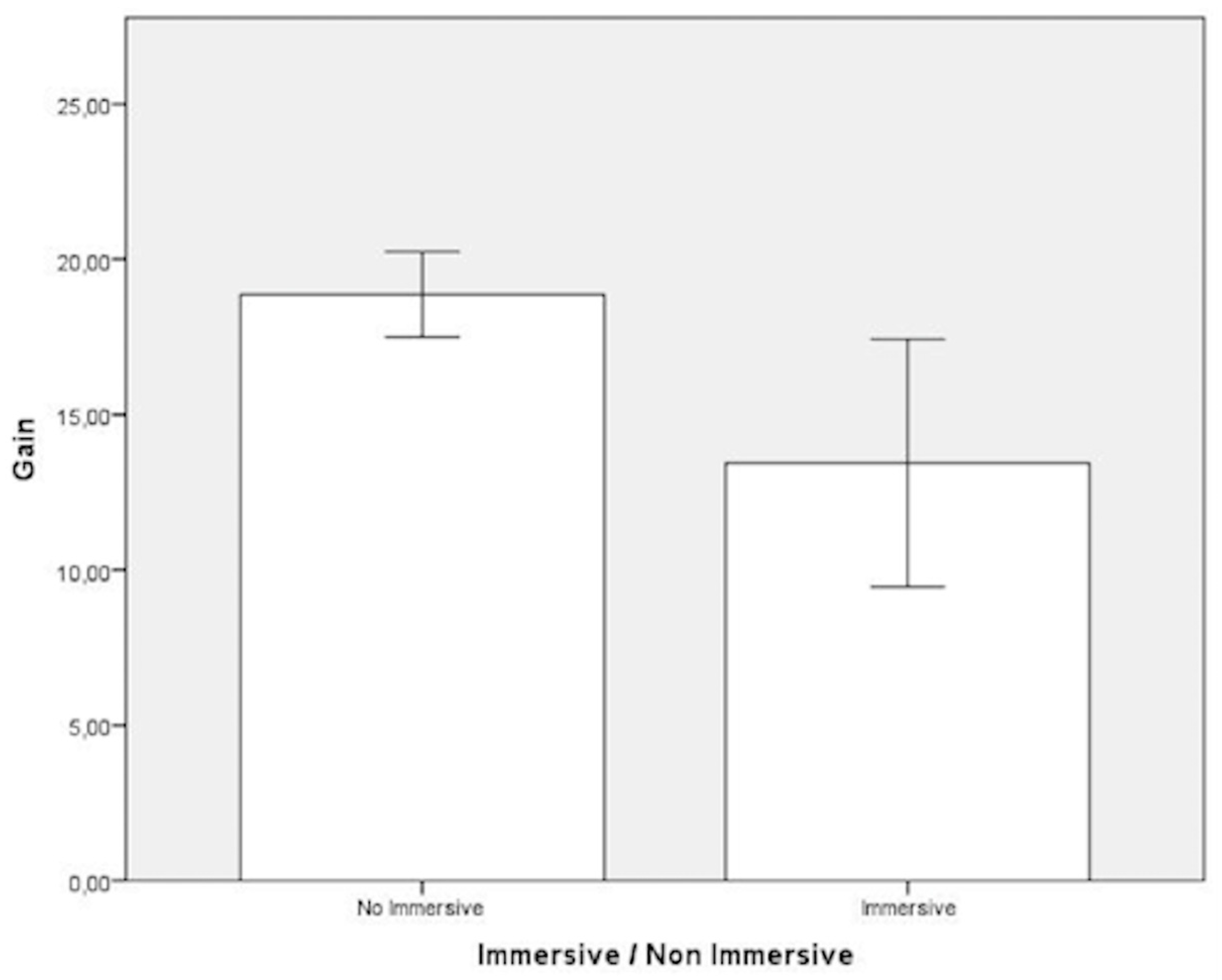Spatial Orientation Skill for Landscape Architecture Education and Professional Practice
Abstract
1. Introduction
2. Materials and Methods
2.1. Participants
2.2. Spatial Orientation Skill Measurement Tool
2.3. Workshops Classifications: Technology, Aactivity, Games, Dimensions, and Immersivity
2.4. Data Processing
3. Workshops
3.1. SDI_1 and SDI_2 Workshops
3.2. Augmented Reality Workshop
3.3. Virtual Reality Immersive Workshop
3.4. Game Engine
3.5. 3D CAD Applications
4. Results
5. Discussion
5.1. Game/No Game Environments
5.2. Technology
5.3. Activity: Survey Learning/Wayfinding
5.4. Diemsions: 2D/3D
5.5. Immersive or Non-Immersive Environments
6. Conclusions
Supplementary Materials
Author Contributions
Funding
Acknowledgments
Conflicts of Interest
References
- Liu, M.; Nijhuis, S. Mapping landscape spaces: Methods for Unerstanding Spatial-Visual Characteristics in Landscape Design. Environ. Impact Assess. Rev. 2020, 82, 106376. [Google Scholar] [CrossRef]
- Kara, B. Landscape Design and Cognitive Psychology. Procedia Soc. Behav. Sci. 2012, 82, 288–291. [Google Scholar] [CrossRef]
- Burley, J.B. The Emergence of Landscape Urbanism: A Chronological Criticism Essay. Land 2018, 7, 147. [Google Scholar] [CrossRef]
- Kastuari, A.; Sewahardhi, D.; Hanan, H.; Wikantika, K. State of the Art of the Landscape Architecture Spatial Data Model from a Geospatial Perspective. In Proceedings of the ISPRS Annals of the Photogrammetry, Remote Sensing and Spatial Information Sciences, Volume IV-2/W1, 2016 11th 3D Geoinfo Conference, Athens, Greece, 20–21 October 2016. [Google Scholar]
- Chaloupska, P.; Hrusova, D.; Chaloupsky, D. Possibilities of Blended Learning to Develop Orientation and Navigation Skills of Tourism Management Students. In Advances in Web-Based Learning—ICWL 2019. ICWL 2019, Proceedings of the 18th International Conference, Magdeburg, Germany, 23–25 September 2019; Herzog, M., Kubincová, Z., Han, P., Temperini, M., Eds.; Springer: Cham, Switzerland, 2019. [Google Scholar]
- National Research Council. Learning to Think Spatially; The National Academies Press: Washington, DC, USA, 2006; pp. 25–48. [Google Scholar] [CrossRef]
- Nielsen, C.P.; Oberle, A.; Sugumaran, R. Implementing a High School Level Geospatial Technologies and Spatial Thinking Course. J. Geogr. 2011, 110, 60–69. [Google Scholar] [CrossRef]
- Akinci, A.; Akinci, C. The Importance of Spatial Ability Research: The Case of Landscape Architecture Education. In Environmental Sustainability and Landscape Management; Efe, R., Gad, A., Cürebal, I., Tóth, B., Eds.; St. Kliment Ohridski University Press: Sofia, Greece, 2016; pp. 535–545. [Google Scholar]
- Cho, J.Y. Spatial Ability, Creativity, and Studio Performance in Architectural Design. In Proceedings of the 17th International Conference on Computer-Aided Architectural Design Research in Asia, Hong Kong, China, 25–28 April 2012; pp. 131–140. [Google Scholar]
- Sinton, D. Spatial Learning in Higher Education. In Space in Mind. Concepts for Spatial Learning and Education; Montello, D.R., Grossner, K., Janelle, D.G., Eds.; The MIT Press: Cambridge, MA, USA, 2014; pp. 222–239. [Google Scholar]
- Tulla, A. Libro Blanco del Título de Grado en Geografía y Ordenación del Territorio; ANECA: Madrid, España, 2004. Available online: http://www.aneca.es/var/media/150444/libroblanco_jun05_geografia.pdf (accessed on 10 April 2020).
- Rúa, E. (coord.) Libro Blanco del Título de Grado en Ingeniería Civil; ANECA: Madrid, España, 2004. Available online: http://www.aneca.es/var/media/150320/libroblanco_ingcivil_def.pdf (accessed on 10 April 2020).
- Hernández León, J.M. (coord.) Libro Blanco del Título de Grado en Arquitectura; ANECA: Madrid, España, 2005. Available online: http://www.aneca.es/var/media/326200/libroblanco_arquitectura_def.pdf (accessed on 10 April 2020).
- Sastre Merlin, A. (coord.) Libro Blanco del Título de Grado en Ciencias Ambientales; ANECA: Madrid, España, 2004. Available online: http://www.aneca.es/var/media/150340/libroblanco_ambientales_def.pdf (accessed on 9 May 2020).
- Alcalde García, M. (coord.) Libro Blanco del Título de Grado en Ingenierías Agrarias e Ingenierías Forestales; ANECA: Madrid, España, 2005. Available online: http://www.aneca.es/var/media/150348/libroblanco_agrarias_forestales_def.pdf (accessed on 9 May 2020).
- Chen, X. STEM Attrition: College Students’ Paths into and Out of STEM Fields. Statistical Analysis Report; NCES 2014-001; US Department of Education: Washington, DC, USA, 2013.
- Higher Education Research Institute. Degrees of Success: Bachelor’s Degree Completion Rates among Initial STEM Majors. Research Brief; University of California: Los Angeles, CA, USA, 2010. [Google Scholar]
- Maier, P. Spatial Geometry and Spatial Ability: How to Make Solid Geometry Solid. In Proceedings of the Annual Conference of Didactics of Mathematics (GDM), Regensburg, Germany, 4–8 March 1996; pp. 69–81. [Google Scholar]
- Smith, I.M. Spatial Ability: Its Educational and Social Significance; University of London Press: London, UK, 1964. [Google Scholar]
- Linn, M.C.; Petersen, A.C. Emergence and Characterization of Sex Differences in Spatial Ability: A Meta-Analysis. Child Dev. 1985, 56, 1479–1498. [Google Scholar] [CrossRef] [PubMed]
- Sorby, S.A. Developing 3-D Spatial Visualization Skills. Eng. Des. Graph. J. 2009, 63, 21–32. [Google Scholar]
- Marunic, G.; Glažar, V. Improvement and Assessment of Spatial Ability in Engineering Education. Eng. Rev. 2014, 34, 139–150. [Google Scholar]
- Weckbacher, L.M.; Okamoto, Y. Mental Rotation Ability in Relation to Self-Perceptions of High School Geometry. Learn. Individ. Differ. 2014, 30, 58–63. [Google Scholar] [CrossRef]
- Bodner, G.; Guay, R. The Purdue Visualization of Rotations Test. Chem. Edu. 1997, 2, 1–18. [Google Scholar] [CrossRef]
- Tartre, L.A. Spatial Orientation Skill and Mathematical Problem Solving. J. Res Math. Educ. 1990, 21, 216–229. [Google Scholar] [CrossRef]
- Krejči, M.; Hradilová, I. Spatial Orientation in the Urban Space in Relation to Landscape Architecture. Acta Univ. Agric. Silvic. Medelianae Brun. 2014, 62, 545–552. [Google Scholar] [CrossRef]
- Krejči, M.; Hradilová, I. Landscape Infographic Design. Eur. Sci. J. 2014, 2, 397–401. [Google Scholar]
- Jorgensen, K.; Karadeniz, N.; Mertents, E.; Stiles, R. The Routledge Handbook of Teaching Landscape; Routledge: New York, NY, USA, 2019; pp. 276–289. [Google Scholar]
- Spanish Cabinet’s Office. Royal Decree 1513/2006 from 7 December. State’s Official Bulletin. 2006. Available online: http://www.boe.es/boe/dias/2006/12/08/pdfs/A43053-43102.pdf (accessed on 1 September 2017).
- Gonzato, M.; Godino, J.D. Aspectos Históricos, Sociales y Educativos de la Orientación Espacial. Unión Rev. Iberoam. Mat. 2011, 23, 24–45. [Google Scholar]
- Ministerio de Ciencia e Innovación, Planes de Estudio, Habilitación Profesional, Boletín Oficial del Estado, 42, 18 de Febrero de 2009, Spain. Available online: http://www.boe.es/boe/dias/2009/02/18/ (accessed on 10 April 2020).
- Ministerio de Ciencia e Innovación, Planes de Estudio, habilitación Profesional, Boletín Oficial del Estado, 43, 19 de Febrero de 2009, Spain. Available online: http://www.boe.es/boe/dias/2009/02/19/ (accessed on 10 April 2020).
- Ministerio de Ciencia e Innovación, Planes de Estudio, Habilitación Profesional, Boletín Oficial del Estado, 44, 20 de Febrero de 2009, Spain. Available online: http://www.boe.es/boe/dias/2009/02/20/ (accessed on 10 April 2020).
- National Council of Teachers of Mathematics. Principles and Standards for School Mathematics; NCTM: Reston, VA, USA, 2000. [Google Scholar]
- Presmeg, N.C. Research on Visualization in Learning and Teaching Mathematics: Emergence from Psychology. In Handbook of Research on the Psychology of Mathematics Education; Gutiérrez, A., Boero, P., Eds.; Sense Publishers: Dordrecht, The Netherlands, 2006. [Google Scholar]
- Battista, M.T. The Development of Geometric and Spatial Thinking. In Second Handbook of Research on Mathematics Teaching and Learning; Lester, F.K., Charlotte, N.C., Eds.; Information Age Publishing: Charlotte, NC, USA, 2007; pp. 843–908. [Google Scholar]
- Gutiérrez, A. Childern’s Ability for Using Different Plane Representations of Space Figures. In New Directions in Geometry Education; Baturro, A.R., Ed.; Centre of Math and Sc. Education, Q.U.T.: Brisbane, Australia, 1996; pp. 33–42. [Google Scholar]
- Kinsey, B. Design of a CAD Integrated Physical Model Rotator. In Proceedings of the Annual Conference & Exposition Engineering Education, Nashville, TN, USA, 22–25 June 2003; American Society of Engineering Education: Washington, DC, USA, 2003. [Google Scholar]
- Newcomer, J.; Raudebaugh, R.; McKell, E.; Kelley, D. Visualization, Freehand Drawing, Solid Modeling, and Design in Introductory Engineering Graphics. In Proceedings of the 29th ASEE/IEEE Frontiers in Education Conference, San Juan, Puerto Rico, 10–13 November 1999. [Google Scholar]
- Reber, A.S. Dictionary of Psychology; Penguin Books Ltd.: London, UK, 2009. [Google Scholar]
- Sorby, S.; Wysocki, A.; Baartmants, B. Introduction to 3D Spatial Visualization: An Active Approach; Thomson Delmar Learning: Clifton Park, NY, USA, 2003. [Google Scholar]
- Cohen, C.A.; Hegarty, M.; Keehner, M.; Montello, D.R. Spatial Ability in the Representation of Cross Sections. In Proceedings of the 25th Annual Conference of the Cognitive Science Society, Boston, MA, USA, 31 July–2 August 2003; pp. 1333–1334. [Google Scholar]
- Hegarty, M.; Waller, D. A Dissociation between Mental Rotation and Perspective-Taking Spatial Abilities. Intelligence 2004, 32, 175–191. [Google Scholar] [CrossRef]
- Kozhevnikov, M.; Hegarty, M. A Dissociation between Object Manipulation, Spatial Ability and Spatial Orientation Ability. Mem. Cogn. 2001, 29, 745–756. [Google Scholar] [CrossRef]
- Harvey, K. Landmarks in the Landscape: Historic Architecture in the National Parks of the West; Chronicie Books: San Francisco, CA, USA, 1997. [Google Scholar]
- De Sousa Silva, C.; Viegas, I.; Panagopoulos, Τ.; Bell, S. Environmental Justice in Accessibility to Green Infrastructure in Two European Cities. Land 2018, 7, 134. [Google Scholar] [CrossRef]
- Christman, Z.; Meenar, M.; Mandarano, L.; Hearing, K. Prioritizing Suitable Locations for Green Stormwater Infrastructure Based on Social Factors in Philadelphia. Land 2018, 7, 145. [Google Scholar] [CrossRef]
- Hill, K.A. Lost Person Behavior; National SAR Secretariat: Ottawa, ON, Canada, 1998.
- Howard, I.P.; Templeton, W.B. Human Spatial Orientation; Wiley: London, UK, 1966. [Google Scholar]
- Golledge, R.G.; Dougherty, V.; Bell, S. Survey Versus Route-Based Wayfinding in Unfamiliar Environments; Working Papers; University of California Transportation Center: Berkeley, CA, USA, 1993; pp. 1–36. [Google Scholar]
- Fields, A.W.; Shelton, A.L. Individual Skill Differences and Large-Scale Environmental Learning. J. Exp. Psychol. Learn. Mem. Cogn. 2006, 32, 506–515. [Google Scholar] [CrossRef]
- Shelton, A.L.; McNamara, T.P. Orientation and Perspective Dependence in Route and Survey Learning. J. Exp. Psychol. Learn. Mem. Cogn. 2004, 30, 158–170. [Google Scholar] [CrossRef]
- Shelton, A.L.; Gabrieli, J.D.E. Neural Correlates of Individual Differences in Spatial Learning Strategies. Neuropsychology 2004, 18, 442–449. [Google Scholar] [CrossRef]
- Gálvez, G. El Aprendizaje de la Orientación en el Espacio Urbano: Una Proposición Para la Enseñanza de la Geometría en la Escuela Primaria. Master’s Thesis, Centro de Investigación del IPN, Ciudad de Mexico D.F., Mexico, 1985. [Google Scholar]
- Carbonell-Carrera, C.; Saorin, J.L.; Hess-Medler, S. Pokémon Go and Imprivement in Spatial Orientation Skills. Prof. Geograph. 2018, 117, 245. [Google Scholar]
- Carbonell-Carrera, C.; Jaeger, A.J.; Shipley, T.F. 2D Cartography Training: Has the Time Come for a Paradigm Shift? ISPRS Int. J. Geo-Inf. 2018, 7, 197. [Google Scholar] [CrossRef]
- Liao, K. The Abilities of Understanding Spatial Relations, Spatial Orientation, and Spatial Visualization Affect 3D Productdesign Performance: Using Carton Box design as an Example. Int. J. Technol. Des. Educ. 2017, 27, 131–147. [Google Scholar] [CrossRef]
- Macnab, W.; Johnstone, A.H. Spatial Skills Which Contribute to Competence in the Biological Science. J. Biol. Educ. 1990, 24, 37–41. [Google Scholar] [CrossRef]
- Lohman, D. Spatial Abilities as Traits, Processes, and Knowledge. In Advances in the Psychology of Human Intelligence; Sternberg, R.J., Ed.; Lawrence Erlbaum: Hillsdale, NJ, USA, 1988; pp. 181–248. [Google Scholar]
- Tory, M.; Möller, T.; Atkins, M.S.; Kirkpatrick, A. Combining 2D and 3D Views for Orientation and Relative Position Tasks. In Proceedings of the SIGCHI Conference on Human Factors in Computing Systems, Vienna, Austria, 24–29 April 2004; pp. 73–80. [Google Scholar] [CrossRef]
- George, D.; Mallery, M. SPSS Statistics 23 Step by Step: A Simple Guide and Reference; Routledge Taylor and Francis: New York, NY, USA, 2016. [Google Scholar]
- Carbonell, C. Spatial-Thinking Knowledge Acquisition from Route-Based Learning and Survey Learning: Improvement of Spatial Orientation Skill with Geographic Information Science Sources. J. Surv. Eng. 2017, 6, 143. [Google Scholar] [CrossRef]
- Carbonell-Carrera, C.; Hess-Medler, S. Spatial Orientation Skill Improvement with Geo-spatial Applications: Report of a Multi-Year Study. ISPRS Int. J. Geo-Inf. 2017, 6, 278. [Google Scholar] [CrossRef]
- Carbonell, C.; Bermejo, L.A. Augmented Reality as a Digital Teaching Environment to Develop Spatial Thinking. Cartogr. Geogr. Inf. Sci. 2017, 44, 259–270. [Google Scholar] [CrossRef]
- Carbonell-Carrera, C.; Saorin, J.L. Virtual Learning Environments to Enhance Spatial Orientation. Eur. J. Math. Sci. Technol. Ed. 2018, 14, 709–719. [Google Scholar] [CrossRef]
- Carbonell-Carrera, C.; Gunalp, P.; Saorin, J.L.; Hess-Medler, S. Think Spatially With Game Engine. ISPRS Int. J. Geoinf. 2020, 9, 159. [Google Scholar] [CrossRef]
- Carbonell-Carrera, C.; Saorin, J.L.; Melián-Díaz, D.; Hess-Medler, S. Spatial Orientation Skill Performance with a Workshop Based on Green Infrastructure in Cities. ISPRS Int. J. Geoinf. 2020, 9, 216. [Google Scholar] [CrossRef]
- Kerr, J.; Lawson, G. Augmented Reality in Design Education: Lawson, G. Augmented Reality in Design Education: As AR Experience. Int. J. Art Des. Edu. 2020, 39, 6–21. [Google Scholar] [CrossRef]
- Choi, H. Geospatial Data Approach for Demand-Oriented Policies of Land Administration. Land 2020, 9, 31. [Google Scholar] [CrossRef]
- Goedert, J.D.; Pawloski, R.; Rokooeisadabad, S.; Subramaniam, M. Project-Oriented Pedagogical Model for Construction Engineering Education Using Cyberinfrastructure Tools. J. Prof. Issues Eng. Educ. Pract. 2013, 139, 301–309. [Google Scholar] [CrossRef]
- Meireles Rodrigues, F.; Lourdes, L. Public Participation Projet-based Learning in Landscape Architecture. WSEAS Trans. Environ. Dev. 2017, 13, 441–451. [Google Scholar]
- Yaman, M.; Abdullah, F.; Rozali, N.F.; Salim, F. The Relevancy of Outdoor Classroom for PBL Approach in Selected University in Kuala Lumpur. J. Malays. Inst. Plan. 2018, 2, 186–196. [Google Scholar] [CrossRef][Green Version]
- Schroth, O.; Zhang, C. Augmented Landform—An Educational Augmented Reality Tool for Landscape Architecture Students. In Peer Reviewed, Proceedings of the Digital Landscape Architecture 2014 at ETH Zurich, 21 May–23 May, 2014; Wissen Hayek, U., Fricker, P., Buhmann, E., Eds.; Herbert Wichmann Verlag, VDE VERLAG GMBH: Berlin/Offenbach, Germany, 2014. [Google Scholar]
- Konopacki, J. The Technology of Augmented Reality - Virtual Reconstructions of Landscape Architecture Design. Tech. Trans. Arch. Issue 2014, 97–112. [Google Scholar] [CrossRef]
- Quaiser-Pohl, C.; Geiser, C.; Lehmann, W. The Relationship between Computer-Game Preference, Gender, and Mentalrotation Ability. Pers. Individ. Differ. 2006, 40, 609–619. [Google Scholar] [CrossRef]
- David, L.T. Training of Spatial Abilities through Computer Games – Results on the Relation between Game’s Task and Psychological Measures that Are Used. Procedia Soc. Behav. Sci. 2012, 33, 323–327. [Google Scholar] [CrossRef]
- Temple University. Spatial Skills may Be Improved through Training, Including Video Games. ScienceDaily. 2012. Available online: www.sciencedaily.com/releases/2012/07/120725120634.htm (accessed on 15 April 2020).
- Spence, I.; Feng, J. Video Games and Spatial Cognition. Rev. Gen. Psychol. 2010, 14, 92–104. [Google Scholar] [CrossRef]
- Panagopoulos, T.; Duque, J.A.G.; Bostenaru Dan, M. Urban Planning with Respect to Environmental Quality and Human Well-being. Environ. Pollut. 2016, 208, 137–144. [Google Scholar] [CrossRef]
- Klatzky, R.L. Allocentric and Egocentric Spatial Representations: Definitions, Distinctions, and Interconnections. In Lecture Notes in Artificial Intelligence 1404: Spatial Cognition—An Interdisciplinary Approach to Representation and Processing of Spatial Knowledge; Freksa, C., Habel, C., Wender, K.F., Eds.; Springer: Berlin, Germany, 1998; pp. 1–17. [Google Scholar]
- Waller, D.; Hunt, E.; Knapp, D. The Transfer of Spatial Knowledge in Virtual Environment Training. Presence 1998, 7, 129–143. [Google Scholar] [CrossRef]
- Villa Sicilia, A. Desarrollo y Evaluación de las Habilidades Espaciales de los Estudiantes de Ingeniería: Actividades y Estrategias de Resolución de Tareas Espaciales. Ph.D. Thesis, Universitat politècnica de Catalunya, Barcelona, Spain, 2 February 2016. Available online: https://upcommons.upc.edu/handle/2117/96294 (accessed on 17 May 2019).
- Imagery Lab Mental Imaginery and Human-Computer Interaction Lab. Available online: http://www.nmr.mgh.harvard.edu/mkozhevnlab/?page_id=9 (accessed on 4 March 2020).





| Workshop | 1 | 2 | 3 | 4 | 5 | 6 |
|---|---|---|---|---|---|---|
| Technology | SDI 1_1 | SDI_2 | AR 2 | VR 3 | Game Engine | 3D CAD applications |
| Activity: survey learning/wayfinding | Survey learning | Survey learning and Wayfinding | Wayfinding | Survey learning and Wayfinding | Wayfinding | |
| Game or Not Game | Not game | Game | Not game | |||
| 2D/3D | 2D | 2D and 3D | 3D | 2D and 3D | 3D | |
| Immersive/non-immersive | Non immersive | Immersive | Non immersive | |||
| Classification | Mean Gain | SD | Gain (%) | n | F | df | p-Value | η2p | |
|---|---|---|---|---|---|---|---|---|---|
| Technology * | SDI_1 | 19.2 | 15.5 | 21.3 | 248 | 2.37 | 5554 | 0.038 | 0.021 |
| SDI_2 | 19.1 | 16.1 | 21.2 | 158 | |||||
| AR | 20.1 | 14.8 | 22.4 | 63 | |||||
| VR | 12.8 | 14.0 | 14.2 | 32 | |||||
| Game Engine | 14.2 | 17.0 | 15.8 | 27 | |||||
| 3D CAD apps | 12.8 | 15.6 | 14.3 | 32 | |||||
| Activity * | Survey Learning | 19.2 | 15.5 | 21.3 | 248 | 4.49 | 2557 | 0.012 | 0.016 |
| Wayfinding | 12.8 | 14.7 | 14.2 | 64 | |||||
| Survey Learning and Wayfinding | 18.8 | 15.9 | 20.9 | 248 | |||||
| Game | No game | 18.5 | 15.6 | 20.6 | 533 | 1.95 | 1558 | 0.163 | 0.003 |
| Game | 14.2 | 17.0 | 15.8 | 27 | |||||
| Dimensions * | 2D | 19.2 | 15.5 | 21.3 | 248 | 4.49 | 2557 | 0.012 | 0.016 |
| 3D | 12.8 | 14.7 | 14.2 | 64 | |||||
| 2D and 3D | 18.8 | 15.9 | 20.9 | 248 | |||||
| Immersion * | No Immersive | 18.6 | 15.8 | 20.7 | 528 | 4.16 | 1558 | 0.042 | 0.007 |
| Immersive | 12.8 | 14.0 | 14.2 | 32 | |||||
| Total | 18.3 | 15.7 | 21.3 | 560 |
© 2020 by the authors. Licensee MDPI, Basel, Switzerland. This article is an open access article distributed under the terms and conditions of the Creative Commons Attribution (CC BY) license (http://creativecommons.org/licenses/by/4.0/).
Share and Cite
Carbonell-Carrera, C.; Saorin, J.L.; Hess-Medler, S. Spatial Orientation Skill for Landscape Architecture Education and Professional Practice. Land 2020, 9, 161. https://doi.org/10.3390/land9050161
Carbonell-Carrera C, Saorin JL, Hess-Medler S. Spatial Orientation Skill for Landscape Architecture Education and Professional Practice. Land. 2020; 9(5):161. https://doi.org/10.3390/land9050161
Chicago/Turabian StyleCarbonell-Carrera, Carlos, Jose Luis Saorin, and Stephany Hess-Medler. 2020. "Spatial Orientation Skill for Landscape Architecture Education and Professional Practice" Land 9, no. 5: 161. https://doi.org/10.3390/land9050161
APA StyleCarbonell-Carrera, C., Saorin, J. L., & Hess-Medler, S. (2020). Spatial Orientation Skill for Landscape Architecture Education and Professional Practice. Land, 9(5), 161. https://doi.org/10.3390/land9050161






